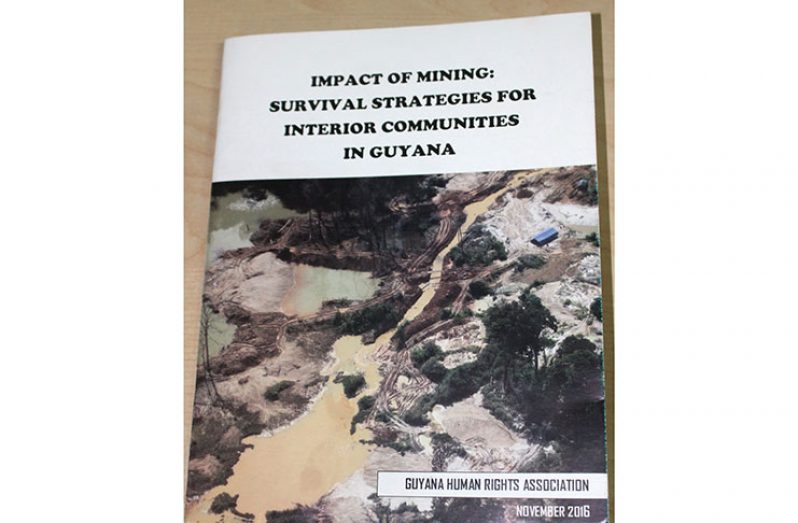BLOOD and gore is fast becoming a way of life at Baramita as young female rape victims traverse the Region One (Barima-Waini) community, armed to the teeth in order to protect and defend themselves.This and other heartbreaking stories of real life in Baramita are among the findings of a report by the Guyana Human Rights Association (GHRA), highlighting the struggles of interior communities in Guyana which are under the influence of mining.
A case study of the community of Baramita, tucked neatly away in the report, titled ‘Impact of Mining: Survival Strategies for Interior Communities in Guyana’ and published November last, exposes the works of darkness and the illicit sex trade among other revelations.
According to the GHRA, sexual exploitation and sexual abuse within Baramita and other mining communities’ present avenues which exalt the sickening problem of exploitation as a way of life.
PREDOMINANTLY CARIB
Baramita is a predominantly Carib community, which, according to the GHRA, “represents the most advanced case of disintegration of an Indigenous community for which the principle cause is mining.”
The religion and language of Baramita’s citizens have prevented opportunities for much intervention, even as residents live partially isolated and endure horrific troubles silently.
With some 30 dredges operating in the area, residents complain that the construction of a road linking Baramita to Matthews Ridge, with the intent or encouraging economic development, has led to an invasion of coastlanders, and the community being transformed into a haunted town.
And with sexual abuse and exploitation on the rise, young girls are now known to be the perpetrators of physically violent crimes in order to protect themselves from being raped time and again, the GHRA reports states.
“Sexual abuse of young girls and women is rampant, beyond anything the Guyana Human Rights Association has learnt about in other parts of the interior,” the report states.
According to the GHRA, because it is difficult for the victims to find someone they could trust to report such matters, some teenage girls have resorted to arming themselves with broken bottles as a means of protection whenever they must go anywhere.
Again, because the perpetrators include police officers, some of the victims are forced to turn for help to the male elders in the sole religious organisation in the community, the Jehovah’s Witnesses, but without much success, as they too are reluctant to engage the police.
NOWHERE TO TURN
The report says that though the church appears to be genuinely concerned about social disorder in the community, it has a severely limited response to issues contributing to such matters.
“The church has a severely limited response. Educational materials on nutrition, sexual harassment and other issues represent the boundary of their engagement with social issues,” the GHRA says in the report, adding:
“When asked how they address sexual harassment of young women and girls in families, Elders responded that they visit and pray.
“Pointed questions of whether they would accompany people to complain to the police, or they themselves register complaints with the police, produced a sense of discomfort.”
For greater action to be taken means that such matters will have to be referred to a ‘higher level’; an all-male national church committee in Georgetown, the report goes on to say.
With an average of one every two weeks, the shockingly high rate of suicide in the Indigenous community is said to be symptomatic of the widespread alienation it suffers. Between 2005 and 2016, more than 73 persons committed suicide in Baramita, most of them by hanging with a rope.
According to the case study, it is common for parents to become drunk while their daughters are being taken into the bush and raped.
“Sexual abuse of young girls,” the report says, “is also widespread in the community, with reports of girls as young as 14 being raped. Girls have been known to walk with the top of broken bottles in their ‘bras’, which they pull out to defend themselves. It is estimated that 70% of the community (men and women) have marks of violence on them as a result of the fighting which accompanies drunkenness.”
STATE OF HOPELESSNESS
The study also documents the testimonies of some concerned residents, highlighting what happens and how they happen. Residents of the community say some miners had taken over land, even those belonging to persons indigenous to the community, infringing on their rights and leaving them in a state of hopelessness.
As one resident explained: “The men who come in to work with these miners usually work for big money, so they have cash to splurge, and would tempt the wives or tempt the family; drunk the men; drunk the wives; abuse them; abuse the children them…”
Without showing any mercy, the resident is quoted as saying; the men would abuse little girls. Some even attack the vulnerable children unexpectedly, while others lure them into having an affair, or bribe irresponsible parents.
According to the report, “Alcohol abuse is widespread. People, including women and teenagers, are drunk in the middle of the day. Sexual abuse of teenage girls, both by adult miners, police and others, is rampant, with parents permitting sexual abuse of their daughters in exchange for liquor… “Sometimes they would give these little girls biscuit and drink; give them money; drunk the parents and carry these little girls in the bush and rape them.”
Most of these incidents take place in the backdam area of the community, and many residents considered decent are totally unaware of what happens.
Residents, however, told the GHRA that sexual harassment is not as prevalent in schools, since students are under the watchful eyes of teachers, and among their peers.
The GHRA says government workers in the area have also observed the sad state of affairs there as a result of miners’ insensitive behaviour, and one government worker described Baramita as “the worst community he has ever worked in.” Institutional protection is particularly needed for women and girls in Baramita before the situation becomes uncontrollable.
“The absence of institutional protection for women and girls, particularly from the police, is a major contributing factor to the crisis in Baramita. Reports of police taking bribes from miners, exploiting women sexually and failing to intervene are widespread,” the GHRA says in the report.
Although government took steps to address the multi-dimensional crisis in Baramita through the creation of an Inter-Ministerial Task Force, and police personnel have been replaced in the community, the GHRA has expressed concern that systematic steps have not been taken to address the issue of suicide, which was revealed since July 2015.
The organisation also says that even though the Indigenous Peoples’ Commission (IPC) has visited the community on several occasions, reports of the concerns of citizens of Baramita have not been made publicly available.




.jpg)









